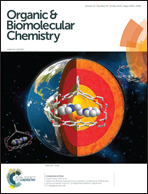Tailoring fluorescent strigolactones for in vivo investigations: a computational and experimental study†
Abstract
Strigolactones (SLs) are a new class of plant hormones whose role has been recently defined in shoot branching, root development and architecture, and nodulation. They are also active in the rhizosphere as signalling molecules in the communication between plants, AMF (arbuscular mycorrhizal fungi) and parasitic weeds. In spite of the crucial and multifaceted biological role of SLs, the current knowledge on the SL biosynthetic pathway and the perception/transduction mechanism is still incomplete. Both genetic and molecular approaches are required to understand the molecular mechanism by which SLs regulate plant development. Our contribution to this topic is the design and synthesis of fluorescent labelled SL analogues to be used as probes for the detection in vivo of the receptor(s). Knowledge of the putative receptor structure will boost the research on analogues of the natural substrates as required for agricultural applications.


 Please wait while we load your content...
Please wait while we load your content...